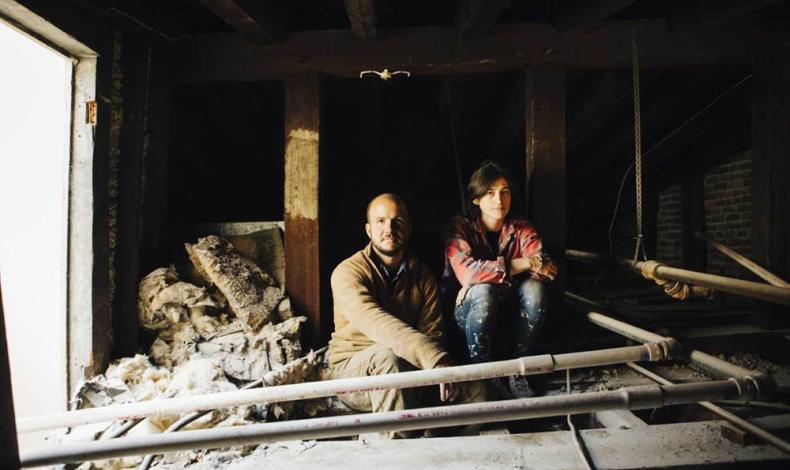Leading by Design: Cypress Building Conservation

In 2013, PennDesign alumni Courtney Williams (MSHP’12) and Michael Shoriak (MSHP’12) founded Cypress Building Conservation in New Orleans, an architectural conservation company specializing in historic materials analysis and hands-on restoration.
Leading by Design explores the work of PennDesign alumni, faculty members, and supporters of the School who are expanding the practice of art and design to meet the challenges of the 21st century.
In 2013, PennDesign alumni Courtney Williams (MSHP’12) and Michael Shoriak (MSHP’12) founded Cypress Building Conservation in New Orleans. Cypress Building Conservation is an architectural conservation company specializing in historic materials analysis and hands-on restoration. Now, as Williams and Shoriak celebrate the 5-year anniversary of their company, Design Weekly caught up with Williams about the duo’s early days, current projects, and hopes for the future of Cypress.
This conversation has been edited for length and clarity.
What did you study at PennDesign?
Michael’s focus was materials conservation, while I gravitated towards property and urban development courses.
What made you decide to start Cypress Building Conservation together?
Mike, who has worked in the construction trades for years, was asked to do a small carpentry job in the French Quarter. It involved window restoration, my graduate school internship focus, so he asked me to help him out. Working with our hands in one of the most historic neighborhoods in the country–well, we pretty quickly realized we wanted to keep doing that, so we decided to make it official.
Where does the name come from? What do you specialize in as a firm?
The name comes from the material fabric that built the city we work in. New Orleans was once a huge cypress swamp. That raw material was shaped into the built fabric that we see and work with today.
Our work is twofold: we are historic materials consultants and commercial contractors. Architects or owners will hire us to conduct building conditions assessments, write cleaning and restoration specifications, or provide construction administration for a project. We have always loved doing the work ourselves, and we realized that serving as the contractor gave us more control over how the work is performed.
Tell me about your first official project together.
Our first job as a historic preservation company was—wait for it—putting in a brand new drywall ceiling in someone’s bathroom! I will say, it was in one of the most significant and beautiful French Quarter townhouses. The ceiling had been damaged after a hurricane let rain in. It was a small job, but the perfect way for us to understand how we worked together, brainstorm what we could be, and figure out what we were doing. I remember we spent about eight hours over margaritas putting together the lowly estimate.
What is it like to practice preservation in New Orleans? How has your time at PennDesign translated to your experience on the ground in this particular city?
We are spoiled by the abundance of historic architecture here. Even “ordinary” houses have incredible charm. At the same time, it is very difficult and often disheartening. Everyone assumes New Orleans is an ideal place to practice preservation, but preservation here is more an image than a material reality. Most architects and contractors “specialize” in historic restoration simply because a majority of buildings are historic. However, they usually don’t have any sort of training in how to treat or understand the historic materials. As a result, we are constantly struggling against contractors, architects, and owners as we specify the proper ways to clean, repair, and maintain historic materials. People fail to understand that rehabbing a building does not mean you are preserving it, if you “rehabbed” it by ripping its guts out.
Without a doubt, we would not be where we are today without PennDesign. We were warned New Orleans is a tough city to break into and that is true. However, several different Penn connections landed us some of our earliest jobs. Those remain some of our coolest and most memorable projects, not to mention the reason for continued work.
What are you working on these days?
We have several different consulting gigs at the moment, but our main focus is serving as the contractor and developer for two 1840s-era brick commercial buildings on Gravier Street in the central business district. They were former cotton and tobacco warehouses. It is, without a doubt, our biggest and hardest project to date, as we are coordinating the entire project from beginning to end. We spearheaded property acquisition, secured construction financing, and helped design the entire project. We are also coordinating federal and state rehabilitation tax credits and serving as the general contractor, and will manage the buildings once they’re put back into use.
When the project is finished, the buildings will host a general store and bar and a black box theater space on the ground floor, with office space (including our new office) and apartments above. The central business district—like that of so many other cities—is definitely seeing a resurgence of activity and redevelopment, so we feel like we have had a small hand in the neighborhood’s diversification.
What do you plan and hope for the next 5 years in Cypress’s life?
Our services continue to evolve in ways we never thought possible with every single project. That being said, we would love to get our noses back in some books and have a research-heavy project sometime soon. We went to PennDesign, after all!
Follow Cypress Building Conservation on Instagram @cypressbldg for photos and videos of their current Gravier Street project.

